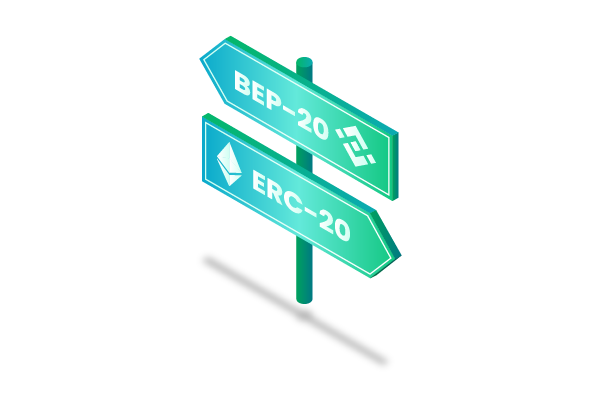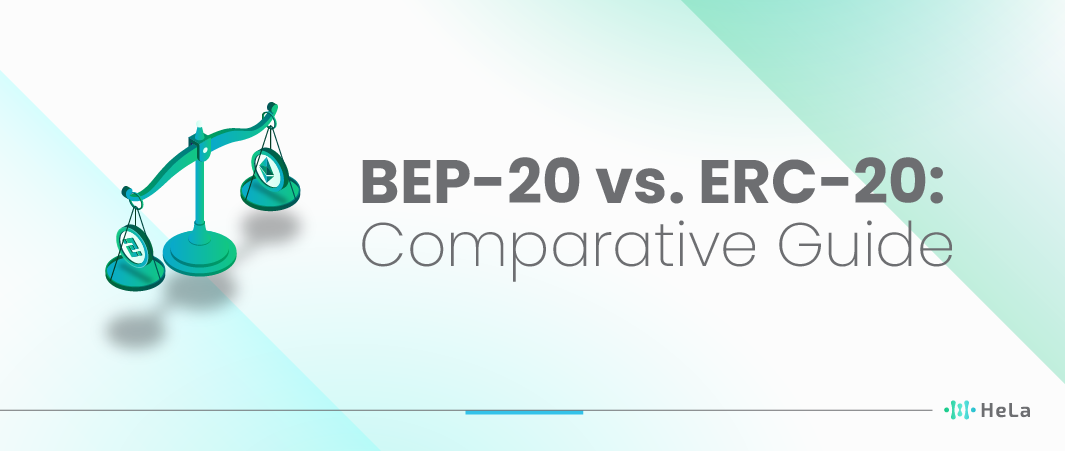The world of blockchain technology is constantly evolving, bringing with it a host of advancements, and at the forefront of these innovations are token standards. These standards play a crucial role in determining how tokens can be moved around, how transactions are verified, and how users can access information about a token. In this guide, we’ll explore the key differences and similarities between BEP-20 and ERC-20, two of the most prominent standards in the decentralized world.
BEP-20 vs. ERC-20: BEP-20 is the native token standard for the Binance Smart Chain, while ERC-20 is the Ethereum equivalent. Both of these standards are designed to make the decentralized world more accessible, but they have their own unique functionalities and use cases.
This guide will provide a comprehensive overview of these standards, shedding light on how they work, what sets them apart, and how they measure up against each other. Whether you’re new to the world of blockchain or an experienced user, understanding the differences and similarities between BEP-20 and ERC-20 is essential for making informed decisions in this rapidly evolving ecosystem.
The Genesis of Token Standards

The development of token standards like BEP-20 and ERC-20 didn’t happen in isolation; they are part of a broader evolution in the world of blockchain and cryptocurrency. These standards emerged to address the need for interoperability, compatibility, and ease of use within their respective ecosystems.
BEP-20 Tokens on Binance Smart Chain
Binance Smart Chain (BSC) was introduced by Binance, one of the largest cryptocurrency exchanges globally, as a means to offer users a more efficient and cost-effective platform for building and using decentralized applications (DApps). BSC was conceived as a parallel chain to Binance Chain, which primarily focused on fast and low-fee transactions. While Binance Chain was ideal for simple transfers and trading, Binance recognized the growing demand for smart contract functionality and the ability to create a wide range of tokens with advanced features.
This is where BEP-20 tokens come into play. BEP-20 tokens are native to Binance Smart Chain and are designed to be fully compatible with projects that already use the BEP-2 standard on Binance Chain. BEP-2 tokens were primarily used for simple asset transfer, while BEP-20 tokens allow for more complex use cases within the BSC ecosystem, such as creating DeFi applications, NFTs, and other smart contract-based solutions. The introduction of BEP-20 tokens thus extended the capabilities of the Binance ecosystem, making it more versatile and appealing to developers and users alike.
ERC-20 Tokens on Ethereum
Ethereum, which was introduced in 2015 by Vitalik Buterin, quickly emerged as a pioneering platform for decentralized applications and smart contracts. As the Ethereum ecosystem grew, so did the need for a standardized token format that could ensure seamless interaction between different tokens and DApps on the Ethereum blockchain.
This led to the creation of ERC-20, which stands for “Ethereum Request for Comment 20.” ERC-20 is a set of rules and standards that specify how tokens on the Ethereum blockchain should behave. These rules encompass crucial aspects like how tokens are transferred, how transactions are approved, and how token balances are managed. The introduction of the ERC-20 standard marked a pivotal moment in the history of blockchain technology. It not only simplified the process of creating and managing tokens but also paved the way for the explosion of Initial Coin Offerings (ICOs) and decentralized applications (DApps) that we saw in the years following its release.
Also Read: Top 24 Stablecoins for Low-Risk Crypto Portfolios in 2025
Both BEP-20 and ERC-20 token standards were born out of the need for compatibility and standardization in their respective blockchain ecosystems. They reflect the ongoing evolution of blockchain technology, moving from simple asset transfers to the creation of versatile, programmable tokens that can power a wide range of decentralized applications. Understanding their origins helps us appreciate their role in shaping the blockchain landscape and the broader cryptocurrency industry.
Key Functionalities of BEP-20 and ERC-20

BEP-20 and ERC-20 are two popular token standards used on different blockchain networks, specifically the Binance Smart Chain (BSC) and the Ethereum blockchain. These token standards share some common characteristics, but they also have unique functionalities and features that distinguish them. Here’s a more detailed overview of the key functionalities of BEP-20 and ERC-20 tokens:
BEP-20 Tokens (Binance Smart Chain)
- Cross-Chain Compatibility: BEP-20 tokens are primarily used on the Binance Smart Chain, but they can also be created to work on other blockchains through cross-chain bridges. This feature allows for interoperability between different blockchain networks.
- Low Transaction Fees: Transactions on the Binance Smart Chain generally have lower fees compared to the Ethereum network, making BEP-20 tokens a cost-effective choice for users and developers.
- High-Speed Transactions: The Binance Smart Chain offers faster block confirmations and shorter block times compared to Ethereum, enabling quicker transactions and better scalability.
- Native Binance Integration: BEP-20 tokens have seamless integration with the Binance exchange and other Binance ecosystem products, making them a popular choice for projects looking to leverage Binance’s services.
- Proof of Stake Authority (PoSA): Binance Smart Chain uses PoSA consensus, combining elements of Proof of Stake (PoS) and Proof of Authority (PoA), which enhances security and scalability.
ERC-20 Tokens (Ethereum)
- Smart Contract Functionality: ERC-20 tokens are fully compatible with Ethereum smart contracts, enabling developers to build complex decentralized applications (DApps) and decentralized finance (DeFi) protocols using these tokens.
- Decentralized Ecosystem: Ethereum’s large and well-established ecosystem offers a wide range of DApps, DeFi projects, and NFT platforms that support ERC-20 tokens, making them a preferred choice for projects seeking to tap into this ecosystem.
- Security and Immutability: Ethereum’s consensus mechanism relies on Proof of Stake (PoS) and, in the future, Proof of Stake (PoS), ensuring a high level of security and network immutability.
- Wider Adoption: ERC-20 tokens have been around for longer and are more widely adopted, which means there is a broader range of wallets and exchanges supporting them.
- Gas Fees: Ethereum’s gas fees can be relatively high during periods of network congestion, which can impact the cost of transactions and smart contract interactions.
While both BEP-20 and ERC-20 tokens serve as the foundation for digital assets on their respective blockchains, they differ in terms of blockchain compatibility, transaction speed, fees, and their integration within their respective ecosystems. Projects and developers choose the token standard that best aligns with their specific requirements and goals, considering factors like cost, speed, and the level of integration with the associated blockchain network.
Advantages & Limitations of BEP-20 and ERC-20
BEP-20 and ERC-20 are two of the most popular token standards used for creating and managing digital tokens on blockchain platforms. Each of these standards has its own set of advantages and limitations:
Advantages of BEP-20 (Binance Smart Chain)
- Low Transaction Fees: BEP-20 tokens are primarily used on the Binance Smart Chain, which is known for its low transaction fees compared to the Ethereum network. This makes it cost-effective for token transfers and interactions.
- Fast Confirmation Times: BEP-20 transactions typically have faster confirmation times compared to Ethereum, thanks to the Binance Smart Chain’s higher throughput.
- Compatibility with Binance Ecosystem: BEP-20 tokens are seamlessly integrated into the Binance ecosystem, which includes Binance Exchange, Binance Wallet, and various other Binance-related services. This can provide more liquidity and accessibility to users.
- Cross-Chain Compatibility: Binance Smart Chain has mechanisms to interact with other blockchains, such as Ethereum. This enables cross-chain asset transfers and bridges, expanding the utility of BEP-20 tokens.
Limitations of BEP-20
- Centralized Control: Binance Smart Chain is more centralized than Ethereum, as it has a smaller number of validators. This raises concerns about the level of decentralization and censorship resistance.
- Smaller Ecosystem: While growing, the Binance Smart Chain ecosystem is still smaller than Ethereum’s. This can result in fewer dApps, projects, and users, which may limit token adoption.
Advantages of ERC-20 (Ethereum)
- Widespread Adoption: ERC-20 tokens are widely adopted and supported in the cryptocurrency space. They are compatible with numerous wallets, exchanges, and services, making them highly accessible.
- Large Developer Community: Ethereum has a massive developer community, leading to a wealth of dApps and projects built on the platform. This can provide more opportunities for token use.
- Security: Ethereum is known for its robust security, and ERC-20 tokens benefit from the security features of the Ethereum network.
- Decentralization: Ethereum is more decentralized than Binance Smart Chain, which aligns with the core principles of blockchain technology.
Limitations of ERC-20
- High Gas Fees: One of the most significant limitations of Ethereum is its high transaction fees, especially during periods of high demand. This can make microtransactions and some use cases impractical.
- Scalability Issues: Ethereum has faced scalability challenges, which can result in network congestion and slower confirmation times during peak usage.
- Complexity for Beginners: Writing and deploying smart contracts on Ethereum can be complex, which can be a barrier for beginners looking to create ERC-20 tokens.
Also Read: Gas Limit: Controlling Execution Costs
Real-World Use Cases
BEP-20 and ERC-20 are two of the most popular token standards on two different blockchain platforms: BEP-20 on Binance Smart Chain (BSC) and ERC-20 on Ethereum. These token standards define a set of rules and functions that ensure compatibility and interoperability between different tokens within their respective ecosystems. Here are some real-world use cases for both BEP-20 and ERC-20 tokens:
BEP-20 (Binance Smart Chain)
- Decentralized Finance (DeFi): Many DeFi projects on BSC issue BEP-20 tokens. These tokens can represent assets like stablecoins (e.g., BUSD), governance tokens (e.g., CAKE for PancakeSwap), or other financial instruments. Users can trade, stake, provide liquidity, and earn rewards with BEP-20 tokens in DeFi protocols.
- Cross-Chain Transfers: BEP-20 tokens can facilitate cross-chain transfers between BSC and other blockchains. For example, wrapped BTC (wBTC) on BSC allows Bitcoin to be used in BSC-based DeFi applications.
- Gaming and NFTs: Gaming projects often issue BEP-20 tokens for in-game assets and NFTs (non-fungible tokens). Gamers can buy, sell, and trade these assets, and developers can use BEP-20 for in-game currencies.
- Tokenized Assets: Real-world assets like real estate or art can be tokenized on BSC using BEP-20 standards, allowing fractional ownership and easy transfer of ownership.
- Crowdfunding and ICOs: BEP-20 tokens can be used for crowdfunding campaigns and initial coin offerings (ICOs) to raise funds for new projects or startups.
ERC-20 (Ethereum)
- Decentralized Finance (DeFi): ERC-20 tokens are the foundation of the Ethereum DeFi ecosystem, used for lending, borrowing, trading, yield farming, and providing liquidity on decentralized exchanges like Uniswap.
- Initial Coin Offerings (ICOs): Many projects used ERC-20 tokens to raise capital through ICOs, although this method has become less popular due to regulatory scrutiny.
- Tokenized Securities: Security tokens built on the ERC-20 standard enable the fractional ownership and trading of traditional assets like stocks, bonds, and real estate in a compliant manner.
- Non-Fungible Tokens (NFTs): While Ethereum has a separate standard for NFTs (ERC-721 and ERC-1155), ERC-20 tokens can also be used for managing in-game assets and other digital collectibles.
- Supply Chain Management: Some projects use ERC-20 tokens to represent goods in a supply chain, ensuring transparency and traceability of products.
- Voting and Governance: Projects often issue ERC-20 tokens to facilitate voting and governance within their communities, allowing token holders to have a say in the project’s direction.
- Charitable Donations: Some charities have issued ERC-20 tokens to track and transparently manage donations and how they are allocated.
Both BEP-20 and ERC-20 tokens offer a wide range of use cases, and their practical applications continue to expand as the blockchain ecosystem evolves. Developers and businesses choose the token standard that best suits their specific needs and the blockchain platform they want to operate on.
Key Differences of BEP-20 vs. ERC-20

BEP-20 and ERC-20 are two different token standards used on different blockchain networks: BEP-20 is used on the Binance Smart Chain (BSC), while ERC-20 is used on the Ethereum network. The major difference between these two standards lies in the blockchain on which they operate and some technical details, but they share many similarities as well. Here are some of the key differences between BEP-20 and ERC-20 tokens:
Blockchain Platform
- BEP-20: This token standard is used on the Binance Smart Chain, which is a blockchain developed by Binance as a parallel chain to the Binance Chain and is compatible with the Ethereum Virtual Machine (EVM).
- ERC-20: ERC-20 tokens are used on the Ethereum blockchain, one of the most popular and widely adopted blockchain networks.
Ecosystem
- BEP-20 tokens are part of the Binance Smart Chain ecosystem, which has its own set of validators, wallets, and development tools.
- ERC-20 tokens are part of the Ethereum ecosystem, which includes a vast array of wallets, exchanges, and dApps.
Transaction Fees
- BEP-20 transactions generally have lower fees than ERC-20 transactions due to the differences in network architecture. Binance Smart Chain was designed to be more cost-effective for transaction processing.
Native Assets
- BEP-20 tokens can be transferred and interact with the native Binance Coin (BNB) on the Binance Smart Chain.
- ERC-20 tokens are typically used in conjunction with Ether (ETH), the native cryptocurrency of the Ethereum network.
Smart Contract Compatibility
- BEP-20 tokens can be used in smart contracts on the Binance Smart Chain, leveraging the BSC’s smart contract functionality.
- ERC-20 tokens can be used in smart contracts on the Ethereum network, interacting with Ethereum’s smart contract infrastructure.
Cross-Chain Compatibility
- BEP-20 tokens are more easily transferrable and interoperable with the Binance Chain due to their shared ecosystem.
- ERC-20 tokens can be bridged to other networks using various solutions like Wrapped Bitcoin (WBTC) on Ethereum.
Development Community
- Each token standard has its own developer community and support, with Ethereum’s ERC-20 having a larger and longer-established community.
It’s important to note that while there are differences between BEP-20 and ERC-20 tokens, both standards serve similar purposes, allowing for the creation of fungible tokens on their respective blockchain networks. The choice between them may depend on factors like network preferences, transaction costs, and specific project requirements.
Conclusion
The blockchain realm is vast, diverse, and ever-evolving. BEP-20 and ERC-20, while differing in origin, functionalities, and applications, both play pivotal roles in expanding the horizons of the decentralized world. While BEP-20 offers efficiency and a rapidly growing ecosystem, ERC-20 stands tall with its widespread acceptance, versatility, and robust foundation.
Users and developers, in the end, need to make choices based on the requirements of their projects and the nuances of each standard. With the rapid developments in blockchain technology, both BEP-20 and ERC-20 promise to offer more advancements, catering to the ever-changing needs of the decentralized ecosystem. One thing is clear: the future of decentralized tokens, whether on Binance Smart Chain or Ethereum, is bright and brimming with possibilities.
Disclaimer: The information provided by HeLa Labs in this article is intended for general informational purposes and does not reflect the company’s opinion. It is not intended as investment advice or recommendations. Readers are strongly advised to conduct their own thorough research and consult with a qualified financial advisor before making any financial decisions.

Joshua Soriano
I am a writer specializing in decentralized systems, digital assets, and Web3 innovation. I develop research-driven explainers, case studies, and thought leadership that connect blockchain infrastructure, smart contract design, and tokenization models to real-world outcomes.
My work focuses on translating complex technical concepts into clear, actionable narratives for builders, businesses, and investors, highlighting transparency, security, and operational efficiency. Each piece blends primary-source research, protocol documentation, and practitioner insights to surface what matters for adoption and risk reduction, helping teams make informed decisions with precise, accessible content.
- Joshua Soriano#molongui-disabled-link
- Joshua Soriano#molongui-disabled-link
- Joshua Soriano#molongui-disabled-link
- Joshua Soriano#molongui-disabled-link

